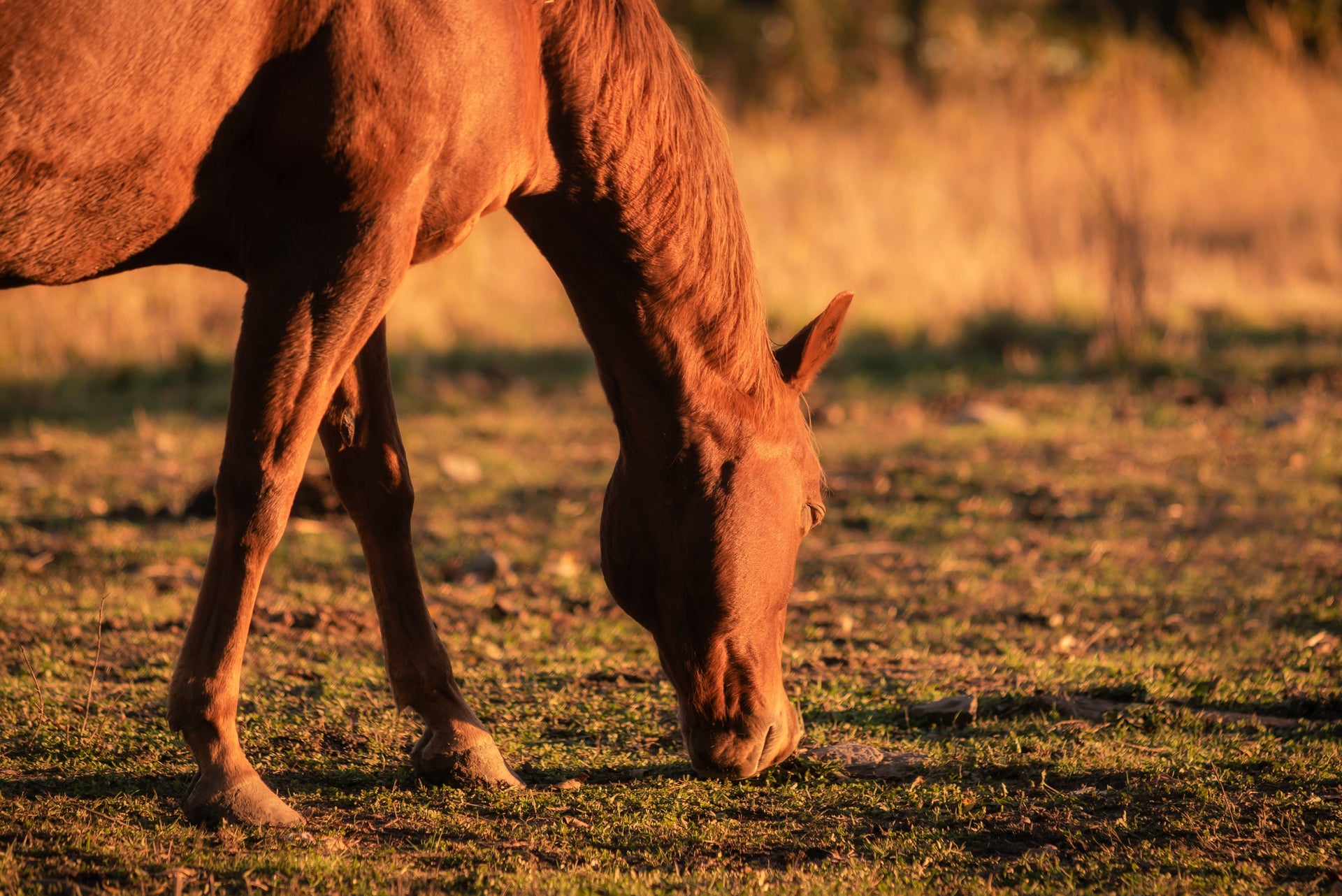For lack of better words, gastric ulcers are painful sores or lesions on the horse’s stomach lining due to damage from stomach acid and other risk factors.
Up to 90% of racehorses and 60% of performance horses have gastric ulcers, and many non-competitive horses also suffer from this condition.
While this issue is pervasive, it can be successfully treated and the risk can be reduced with veterinary care, medication, nutritional changes, and management adjustments to the horse’s daily life.
What Causes Ulcers in Horses?
Most ulcer cases are a result of our modern horse’s lifestyles and management practices. Let us explain.
Stomach acid is an important part of a horse’s digestion.
It is secreted from the lower portion of the stomach (called the glandular region) and is necessary for the initial steps of the digestion process. Because horses are designed to graze around the clock (the average-sized horse needs to consume about 10-20 pounds of roughage per day and in nature horses will graze up to 18 hours per day), their body produces stomach acid 24/7, even if they are not eating.
This is very different from our own digestive system, which turns stomach acid on and off when we need to eat a meal. In fact, horses produce a shocking 16 GALLONS of gastric acid each day!
The glandular region of the stomach also produces mucus and bicarbonate, which help protect the lower portion of the stomach from the acid it is producing. Additionally, saliva, which increases during grazing, contains bicarbonate, which helps to neutralize stomach acid. Research suggests that horses who have the opportunity to graze all day may produce up to 9 - 10 gallons of saliva in a day, which helps offset the constant large volume of acid.
In modern domestic settings, however, it is common that horses are fed periodic forage meals (think 1-2 flakes of hay at certain times of day), with periods of fasting in between. When a horse only consumes forage a few times per day, the continually-produced stomach acid is not being buffered.
Why Do Active Horses Get Gastric Ulcers More Than Sedentary Ones?
Thinking back to the statistic above, why is it that performance horses are more prone to gastric ulcers?
Research has shown that exercise can increase gastric acid production while decreasing blood flow to the GI tract. Think about it: In exercise, blood needs to flow to the legs and muscles, not the digestive system.
Additionally, during exercise, acidic stomach fluid can splash up onto the upper portion of the stomach. The upper half of the stomach (or the non-glandular region) does not produce protective mucus like the lower portion, leaving it vulnerable to ulceration.
Stress in many forms also increases a horse’s risk of gastric ulcers, and research has shown that ulcers can form in as little as five days! Common stressors include travel, competition, schedule changes, stall confinement, loss of a pasture mate, and more.
Additionally, use of nonsteroidal anti-inflammatory drugs (NSAIDs) including bute and Banamine®, reduce the amount of healthy, protective mucus in the gastrointestinal tract, which can make horses more vulnerable to ulcers when administered long-term.
Signs of Ulcers in Horses
While some horses show obvious outward signs of discomfort and distress, it’s important to keep in mind that many horses do not display obvious indications. Often, recognizing ulcers requires a high level of attunement to your horse’s behavior.
Some signs to watch for include:
- Decreased performance
- Changes in attitude and behavior
- Decreased appetite overall
- Disinterest in eating grain/concentrates in particular
- Weight loss
- Dullness
- Resistance to training
- Rough hair coat
- Poor body condition
- Cinchiness
- Colic
If your horse has a more serious case of ulcers, they may exhibit more obvious abdominal pain, colic, or even grind their teeth. Some horses may lay on their back in an effort to relieve the pain in their stomach. They may stop eating mid-meal due to pain if food reaches the stomach during the meal.
In many cases, the signs are subtle and require you to know your horse on an individual basis. For example, some horses stop finishing their grain, and that can be enough of a reason to call your veterinarian.
Ulcer Treatment for Horses
In order to accurately diagnose ulcers, your veterinarian will perform a gastric endoscopy or gastroscopy—running an endoscope (camera) through the horse’s nose into the stomach to visually check for ulcers.
GastroGuard® (omeprazole) is the only medication approved by the United States Food and Drug Administration (FDA) to treat gastric ulcers in horses. Ths flavored oral paste is administered once a day for about 4-6 weeks, or as prescribed by your veterinarian. It is costly, but effective at resolving gastric ulcers by inhibiting gastric acid production, which gives the stomach a chance to heal. There are also additional medications that your veterinarian may recommend as a complement to GastroGard®.
If your horse is displaying signs of ulcers, or if they’re experiencing stressful conditions that can cause gastric ulcers, you’ll want to discuss diagnosis and treatment plans with your veterinarian. Your vet can recommend length of treatment, any suggested rechecks, and prevention moving forward.
From a nutritional perspective, alfalfa hay may be a valuable addition to your horse’s diet. Alfalfa contains high levels of bicarbonate and calcium which can coat the horse’s stomach and help protect it from acid.
Consider adding some alfalfa to your horse’s diet and feeding it 30 minutes prior to exercise, as the presence of bicarbonate in the stomach can help protect the non-glandular region from splashing acid during exercise.
Keep in mind that these suggestions should be discussed with your veterinarian and a professional equine nutritionist.
Can Gastric Ulcers Be Prevented?
While most horses can recover from gastric ulcers with the proper treatment and attention, management protocols can help reduce chances of your horse developing gastric ulcers in the first place.
First, if your horse is not already overweight or at risk for metabolic conditions and laminitis, consider providing free choice hay or pasture.
For horses not on free choice forage, aim to feed at least three or four small meals per day. This helps keep roughage in the horse’s stomach to buffer against gastric acid, as well as stimulate more saliva production, which neutralizes the acid.
Consider adding alfalfa hay, and reducing the amount of grain or concentrate your horse consumes, as the sugars in feed concentrates like grain, contribute to increased acidity in the stomach. Of course, consult your veterinarian and nutritionist before making any changes to your horse’s diet, and always make feed changes gradually over the course of 7-10 days to avoid digestive upset.
Work with your veterinarian to reduce or eliminate long-term usage of NSAID medications, if possible.
Do your best to reduce your horse’s exposure to stressful situations, such as travel and intense training.
Give your horse turnout time, access to forage and the chance to see and socialize with other horses, especially if stalled for long periods of time.
UlcerGard®(lower dose omeprazole paste) is the over-the-counter medication that is FDA-approved to prevent gastric ulcers. This medication is intended to be administered proactively during times of added stress, such as travel and horse shows.
Can Supplements Aid in Gastric Health?
6666 Complete Gut Protection is formulated to support the horse’s whole gastrointestinal tract, from stomach to hindgut. This product includes a novel yeast probiotic that can help reduce the risk of gastrointestinal disturbances, and oat beta-glucan, a prebiotic that helps support a healthy stomach lining.
This equine supplement also contains L-glutamine, the amino acid that is the GI cells’ preferred energy source, which means it supports normal turnover in stomach tissue.
The historic Four Sixes Ranch in Guthrie, Texas is well known for its 150 year legacy of raising the best American Quarter Horses. To continue the heritage of best-in-class horse care, the ranch partnered with leading veterinarians and nutritionists to develop the Four Sixes Ranch Nutriments line of equine supplements.
The hard working horses at the Four Sixes are supported by 6666 Complete Gut Protection. In fact, the ranch’s Stallion Manager, Eric, says of this formula:
“All stallions, regardless, get Complete Gut Protection. With the weather changes and everything that goes on out here in West Texas, we try to keep everything happy in all of the stress these horses go through. A lot of factors affect semen and collection quality. A major part of that is nutrition.
We’ve been using Ranch Nutriments for a little over a year now. These studs eat it up. We don’t have to worry about palatability issues. These supplements really help the horses out, especially when we are asking the most of them.”
Try 6666 Complete Gut Protection today, risk-free!
Photo by Gilles Seguin on Unsplash



